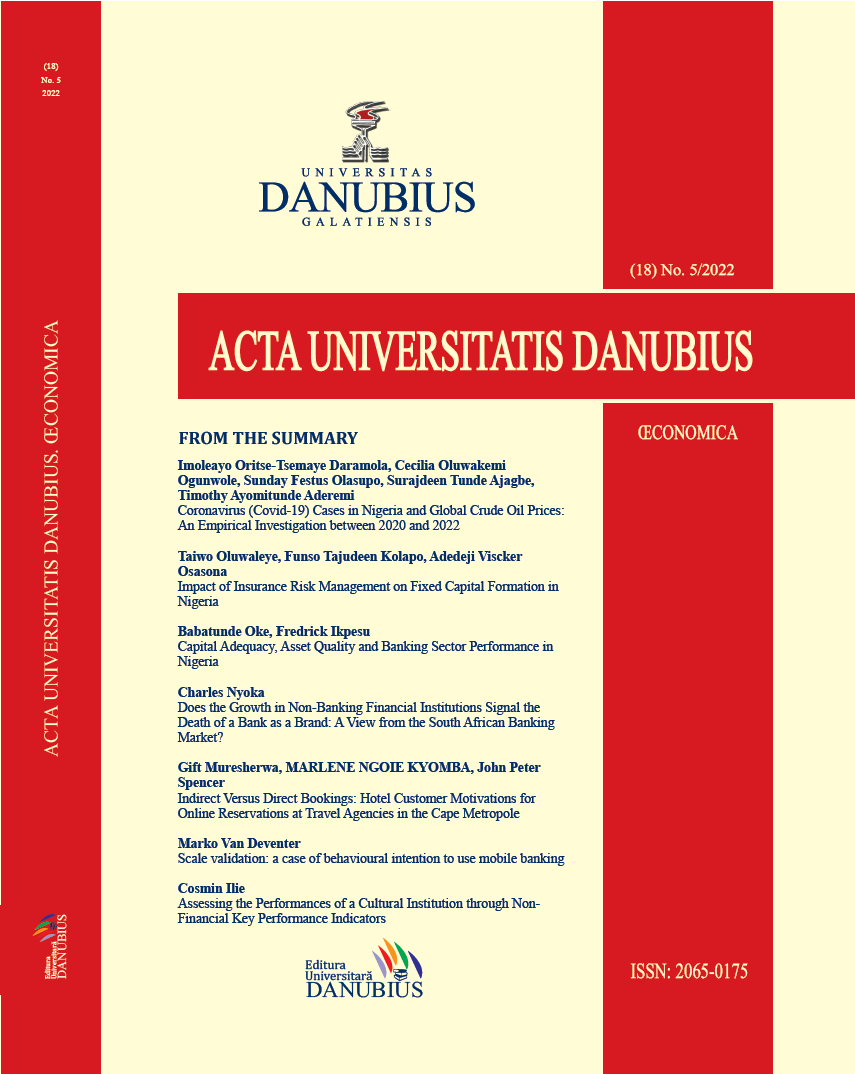An investigation of the macroeconomic determinants of consumption spending in South Africa
Abstract
Household consumption has become a force to be reckoned with in contributing to Sustainable Development Goals. Understanding the determinants that influence household consumption has become a priority especially in emerging countries. Thus, the study examined the macroeconomic factors that influence household consumption in South Africa from 1984–2021 focusing on economic growth, interest rate, unemployment, and inflation. The study is envisaged to contribute to the scant empirical literature on consumption expenditure in the South Africa’s context, thus, contributing to the macroeconomics literature body of knowledge. To achieve this aim, the study employed an Autoregressive distributive lag (ARDL) model due to its unique characteristic of forecasting and disentangling the long-run relationship among the variables from short-run relationship. The ARDL results illustrate a comprehensive outlook on the factors that contribute to consumption spending in South Africa. Amidst the most telling, in the long-run is the population growth and remittances that increases consumption spending in South Africa. Noteworthy is that unemployment, high inflation rates and high interest rates continue to create a detrimental consumption environment. Going forward a multipronged approach that includes reforming the African labour markets, creating a good political stability and employing favourable monetary policies that favours employment and lowering of interest rates should be considered
References
Ando, A., & Modigliani, F. (1963). The life-cycle hypothesis of saving aggregate implications and tests. American Economic Review, 53(1), 55–84.
Bokana, K. G., & Kabongo W. N. S. (2018). modelling real private consumption expenditure in south africa to test the absolute income hypothesis. Journal of Economics and Behavioural Studies, AMH International, 10(5), 138–155.
Burda, M. C., & Wyplosz, C. (2005). Macroeconomics: A European text (5th ed.). Oxford University Press.
Campos, R. G., & Reggio, I. (2014). Consumption in the shadow of unemployment. In Banco de España, Working Papers 1411. https://doi.org/10.2139/ssrn.2457800
De Jongh, J. J., & Mncayi, N. P. (2018). An analysis on the key Macroeconomic drivers of consumer vulnerability in the South African economy. Journal of Contemporary Management, 16(1), 290–312. https://doi.org/10.35683/jcm197.0015
Duesenberry, J. S. (1949). Income, saving, and the theory of consumer behavior. Harvard University Press, Cambridge.
Fuhrer, J. C. (1992). Do consumers behave as the life-cycle/permanent-income theory of consumption predicts? Economic Review, 9(2), 3–14.
Ganong, P., & Noel, P. (2019). Consumer spending during unemployment: positive and normative implications. American Economic Review, 109(7), 23832424. https://doi.org/10.1257/aer.20170537
Garidzirai, R., & Chikuruwo, R. E. (2020). An economic analysis of the social grant policy in South Africa. Journal of Advanced Research in Law and Economics, 11(2), 362–369. https://doi.org/10.14505/jarle.v11.2(48).09
Garidzirai, R., & Matiza, T. (2020). exploring the tourism-poverty alleviation nexus in The Brics Group of Nations. Ekonomika, 99(1), 93–109. https://doi.org/10.15388/Ekon.2020.1.6
Ganivet, E. (2020). Growth in human population and consumption both need to be addressed to reach an ecologically sustainable future. Environ Dev Sustain 22, 4979–4998 (2020). https://doi.org/10.1007/s10668-019-00446-w
Guo, W.W. (2018), An analysis of energy consumption and economic growth of Cobb-Douglas production function based on ECM. In IOP Conference Series: Earth and Environmental Science, Vol. 113, p012071. IOP Publishing. https://doi.org/10.1088/1755-1315/113/1/012071
Hall, R. (1978). Stochastic implications of the life cycle-permanent income hypothesis: theory and evidence. Journal of Political Economy, 86(6), 971–987. https://doi.org/10.1086/260724
Hausman, J. K., & Wieland, J. (2014). Abenomics: Preliminary analysis and outlook (4 ed.). Brookings papers on economic activity. https://doi.org/10.1353/eca.2014.0001
Holm, M. B, Paul, P., & Tischbirek, A. (2020). The transmission of monetary policy under the microscope. Federal Reserve Bank of San Francisco Working Paper 2020-03. European Central Bank. https://doi.org/10.24148/wp2020-03
Keynes, J. M. (1936). The general theory of employment, interest and money. Macmillan.
Lieb, L., Schuffels, J. Inflation expectations and consumer spending: the role of household balance sheets. Empir Econ (2022). https://doi.org/10.1007/s00181-022-02222-8
Mason, A. (2020). Six Ways Population Change Will Affect the Global Economy. Population and development review, 48(1). https://doi.org/10.1111/padr.12469
Mian, A., Rao, K., & Sufi, A. (2013). Household balance sheets, consumption and the economic slump. The Quarterly Journal of Economics, 128(4), 1687–1726. https://doi.org/10.1093/qje/qjt020
Mohr, P. (2020). Economics for South African students (6th ed.). Van Schaik. Pretoria.
Muzindutsi, P., & Mjeso, T. (2018). Analysis of South African household consumption expenditure and its determinants: Application of the ARDL Model. EuroEconomica, 37(3), 169–179.
National Treasury. (2019). Estimates of National Expenditure. http://www.treasury.gov.za/documents/national%20budget/2019/ene/FullENE.pdf
Nyamekye, G., & Poku, E. (2017, March 31). What is the effect of inflation on consumer spending behaviour? In Munich Personal RepEc Archive (p. 588).
Owusu-Sekyere, E. (2017). The impact of monetary policy on household consumption in South Africa. South African Journal of Economics and Management science, 20(1), 598. https://doi.org/10.4102/sajems.v20i1.1660
Pasara, M. T., & Garidzirai, R. (2020). Causality effects among gross capital formation, unemployment and economic growth in South Africa. Economies 2020, 8(2), 112. https://doi.org/10.3390/economies8020026
Pesaran, M. H., & Shin, S. (1999). An autoregressive distributed lag modelling approach to cointegration analysis. In Econometrics and economic theory in the 20th century: The Ragnar Frisch Centennial Symposium. S. Strøm (Ed.). Cambridge University Press.
Statistics South Africa. (2020). Consumer Price Index. http://www.statssa.gov.za/publications/P0141/P0141February2020.pdf
South Africa Reserve Bank (SARB). (2020). Monetary policy review. https://www.resbank.co.za/Lists/News%20and%20Publications/Attachments/9839/Monetary%20Policy%20Review%20%E2%80%93%20April%202020.pdf
Deb, Surajit (2016) : Ageing and consumer spending: Some preliminary findings from India and China, ARTNeT Working Paper Series, No. 163, Asia-Pacific Research and Training Network on Trade (ARTNeT), Bangkok
Trading Economics. (2020). South Africa Consumption spending. https://tradingeconomics.com/south-africa/consumer-spending
World Bank. (2020a). Final consumption expenditure as a percentage of gross domestic product. https://data.worldbank.org/indicator/NE.CON.TOTL.ZS
World Bank. (2020b). South Africa Overview. https://www.worldbank.org/en/country/southafrica
Zhanje, S., & Garidzirai, R. (2018, 0406 July). Export performance and foreign direct investment in Zimbabwe: An ARDL Approach [Conference presentation]. 3rd Annual International Conference on Public Administration and Development Alternatives. Stellenbosch University, Saldahna Bay, South Africa.
Downloads
Published
How to Cite
Issue
Section
License
Copyright (c) 2022 Rufaro Garidzirai, Arthur Mapanga

This work is licensed under a Creative Commons Attribution-NonCommercial 4.0 International License.
The author fully assumes the content originality and the holograph signature makes him responsible in case of trial.


